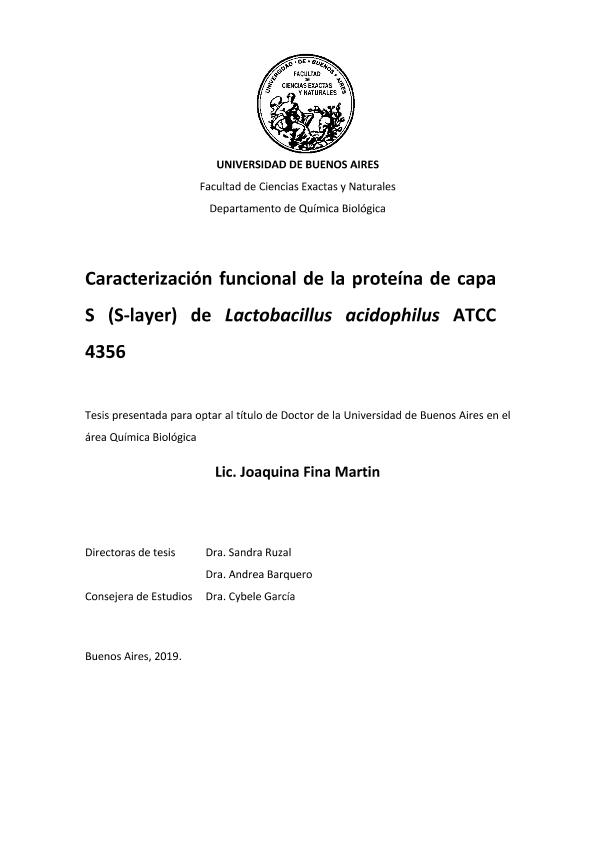Tesis doctoral
La envoltura bacteriana de Lactobacillus acidophilus ATCC 4356 tiene las características de una bacteria Gram positiva, pero además posee proteínas de superficie o Surface layers (S-layers), las cuales se asocian con roles de protección contra enzimas hidrolíticas, cambios de pH y estrés, la captación de moléculas y iones, y ayudan a mantener la forma y rigidez de la célula. Además, varios reportes sugieren que en los lactobacilos la S-layer tendría un rol en las propiedades probióticas de las cepas que la poseen, sin embargo las funciones y los mecanismos involucrados están poco descriptos. El objetivo general de esta Tesis doctoral fue caracterizar funcional y estructuralmente la S-layer de Lactobacillus acidophilus ATCC 4356. Los resultados obtenidos permitieron confirmar que la S-layer presenta un comportamiento homólogo a las lectinas, capaz de interactuar con eritrocitos de carnero, células bacterianas, levaduras, virus y células eucariotas. Respecto a los posibles carbohidratos con los cuales interactúa, se observó un comportamiento mixto asemejándose tanto a las lectinas que reconocen quitina/N-acetilglucosamina como a las de reconocimiento de ácido siálico/manosa. Mediante diferentes ensayos, como el clonado y expresión de proteínas o partes de la proteína conjugadas con la proteína verde fluorescente GFP, se logró identificar los dos dominios de reconocimiento a carbohidratos (CRD) ubicados en la porción carboxilo-terminal y predichos del análisis in silico de la proteína. La actividad de lectina depende de la presencia de estos CRD. También quedó demostrado que el ácido lipoteicoico sirve como un ancla para la proteína SlpA. Además, fue posible determinar cómo se modifica la expresión de los tres genes que codifican para S-layer en esta cepa: slpA, slpB y slpX, en respuesta a cambios ambientales como la alta concentración salina. Se observaron cambios en la expresión génica de los ARNm slpA y la slpX pero no slpB. En consecuencia, la cantidad de las proteínas SlpA y SlpX se modifican no solo por la condición de alta sal (NaCl 0,6 M) sino también por la fase de crecimiento. Por otro lado, en los últimos años se han desarrollado o sugerido diversas aplicaciones biológicas para las proteínas S-layers de Lactobacillus, en este trabajo se pudo establecer que la proteína S-layer disminuye la adherencia y la formación de biopelículas de Pseudomonas aeruginosa en superficies bióticas y abióticas, respectivamente. Además fue capaz de modular la infección de diferentes virus, con una notable actividad pro-viral, facilitando las etapas tempranas del ciclo de infección de tres virus empleados como vectores oncolíticos: el herpes virus simplex tipo 1 (HSV-1), el virus de la estomatitis vesicular y el adenovirus 5. La proteína S-layer también fue capaz de proteger al virus HSV-1 de la inactivación térmica por calor.En conjunto estos resultados aportan a comprender las características estructurales y funcionales de la S-layer, y permiten proponer futuras aplicaciones biológicas. Lactobacillus acidophilus ATCC 4356 cell wall has the characteristics of Gram-positive bacteria, and exhibits Surface layers proteins (S-layer), which protect the bacteria against hydrolytic enzymes; stress and pH changes interact to molecules and ions and maintain the shape and rigidity of the cell. Several reports suggest that Lactobacillus Slayer may be involved in the probiotic properties of the strain, though its function and mechanisms are not yet fully elucidated. The general objective of this thesis was to characterize functional and structurally Lactobacillus acidophilus ATCC 4356’s S-layers. The results obtained confirmed that S-layer presents homologous behaviour to lectins, interacting with sheep erythrocytes, bacteria, yeasts, virus and eukaryotic cells. Regarding the interaction with carbohydrates, it showed a complex behaviour, similar to lectins that recognize either chitin/N-acetilglucosamine or the sialic acid/mannose. By different assays such as cloning and expression of proteins or chimeric fragments conjugated with green fluorescent protein GFP, it was possible to identify two carbohydrate recognition domains (CRD) localized at the C-terminus portion which had been predicted in silico. The lectin activity depends of these CRD. It was also shown that lipoteic acid serves as an anchor for the SlpA protein. Also, it was determined that the expression of the three genes that encodes for S-layer in this strain, slpA, slpB y slpX, is regulated by environmental factors such as high saline concentration. Changes in gene expression of slpA and slpX mRNA but not of slpB were observed. It was also noted that the amount of SlpA and SlpX proteins is modified not only by salt concentration (NaCl 0,6M) but also by growth phase. On the other hand, during the last years several biological applications have been developed for Lactobacillus S-layer protein and in this work it was stablished that S-layer diminishes the adherence and biofilm formation of Pseudomonas aeruginosa on both biotic and abiotic surfaces, respectively. Besides, it was able to modulate the infection of different viruses, exhibiting a noticeable pro-viral activity, facilitating early stages of infection of three of the viruses that are useful as oncolytic vectors: herpes simplex type 1 virus (HSV-1), vesicular stomatitis and adenovirus 5. The S-layer protein was able to protect HSV-1 from heat inactivation. Altogether, these results contribute to comprehend the structural and functional characteristics of S-layer, and allow propose future biological applications.
Caracterización funcional de la proteína de capa S (S-layer) de Lactobacillus acidophilus ATCC 4356
Fina Martin, Joaquina

Director:
Ruzal, Sandra Mónica

Codirector:
Barquero, Andrea Alejandra

Fecha de publicación:
27/03/2019
Idioma:
Español
Clasificación temática:
Resumen
Archivos asociados
Licencia
Identificadores
Colecciones
Tesis(IQUIBICEN)
Tesis de INSTITUTO DE QUIMICA BIOLOGICA DE LA FACULTAD DE CS. EXACTAS Y NATURALES
Tesis de INSTITUTO DE QUIMICA BIOLOGICA DE LA FACULTAD DE CS. EXACTAS Y NATURALES
Citación
Fina Martin, Joaquina; Ruzal, Sandra Mónica; Barquero, Andrea Alejandra; Caracterización funcional de la proteína de capa S (S-layer) de Lactobacillus acidophilus ATCC 4356; 27-3-2019
Compartir



